
Abydos is one of the oldest cities of ancient Egypt, and also of the eighth nome in Upper Egypt. It is located about 11 kilometres west of the Nile at latitude 26° 10' N, near the modern Egyptian towns of El Araba El Madfuna and El Balyana. In the ancient Egyptian language, the city was called Abedju (Arabic Abdu عبد-و). The English name Abydos comes from the Greek Ἄβυδος, a name borrowed by Greek geographers from the unrelated city of Abydos on the Hellespont. Abydos name in hieroglyphs
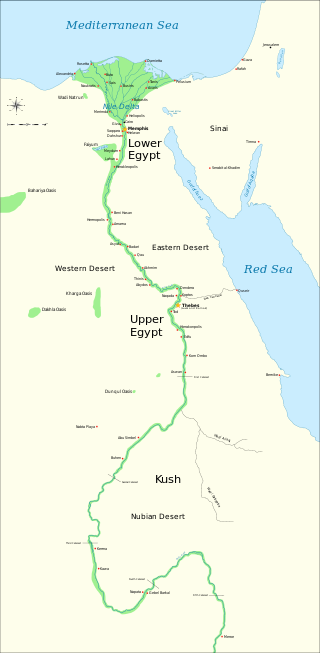
The First Intermediate Period, described as a 'dark period' in ancient Egyptian history, spanned approximately 125 years, c. 2181–2055 BC, after the end of the Old Kingdom. It comprises the Seventh, Eighth, Ninth, Tenth, and part of the Eleventh Dynasties. The concept of a "First Intermediate Period" was coined in 1926 by Egyptologists Georg Steindorff and Henri Frankfort.

Senenmut was an 18th Dynasty ancient Egyptian architect and government official. His name translates literally as "mother's brother."

Deir el-Bahari or Dayr al-Bahri is a complex of mortuary temples and tombs located on the west bank of the Nile, opposite the city of Luxor, Egypt. This is a part of the Theban Necropolis.

Mentuhotep II, also known under his prenomen Nebhepetre, was an ancient Egyptian pharaoh, the sixth ruler of the Eleventh Dynasty. He is credited with reuniting Egypt, thus ending the turbulent First Intermediate Period and becoming the first pharaoh of the Middle Kingdom. He reigned for 51 years, according to the Turin King List. Mentuhotep II succeeded his father Intef III on the throne and was in turn succeeded by his son Mentuhotep III.

Wahankh Intef II was the third ruler of the Eleventh Dynasty of Egypt during the First Intermediate Period. He reigned for almost fifty years from 2112 BC to 2063 BC. His capital was located at Thebes. In his time, Egypt was split between several local dynasties. He was buried in a saff tomb at El-Tarif.

Ancient Egyptian art refers to art produced in ancient Egypt between the 6th millennium BC and the 4th century AD, spanning from Prehistoric Egypt until the Christianization of Roman Egypt. It includes paintings, sculptures, drawings on papyrus, faience, jewelry, ivories, architecture, and other art media. It was a conservative tradition whose style changed very little over time. Much of the surviving examples comes from tombs and monuments, giving insight into the ancient Egyptian afterlife beliefs.

QV66 is the tomb of Nefertari, the Great Wife of Pharaoh Ramesses II, in Egypt's Valley of the Queens. It was discovered by Ernesto Schiaparelli in 1904. It is called the Sistine Chapel of Ancient Egypt. Nefertari, which means "beautiful companion", was Ramesses II's favorite wife; he went out of his way to make this obvious, referring to her as "the one for whom the sun shines" in his writings, built the Temple of Hathor to idolize her as a deity, and commissioned portraiture wall paintings. In the Valley of the Queens, Nefertari's tomb once held the mummified body and representative symbolisms of her, consistent with most Egyptian tombs of the period. Now, everything had been looted except for two thirds of the 5,200 square feet of wall paintings. For what still remains, these wall paintings characterized Nefertari's character. Her face received particular attention to emphasize her beauty, especially the shape of her eyes, the blush of her cheeks, and her eyebrows. Some paintings were full of lines and color of red, blue, yellow, and green that portrayed exquisite directions to navigating through the afterlife to paradise.
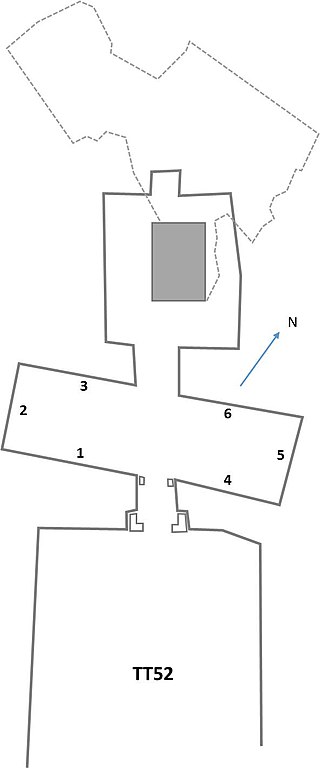
The Theban Tomb TT52 is located in Sheikh Abd el-Qurna, part of the Theban Necropolis, on the west bank of the Nile, opposite to Luxor. It is the burial place of Nakht, an ancient Egyptian official who held the position of a scribe and astronomer of Amun, probably during the reign of Thutmose IV during the Eighteenth Dynasty, the first dynasty of the New Kingdom.

TT1 is the burial place of the ancient Egyptian official Sennedjem and members of his family in Deir el-Medina, on the west bank of the Nile opposite Luxor. The funerary complex consists of three pyramid-shaped chapels dedicated to, from south to north, Sennedjem's father or brother, Sennedjem himself, and to Sennedjem's son Khonsu. Of the three shafts associated with the chapels, only the shaft in front of Sennedjem's chapel was unrobbed. It led to a series of underground rooms, including the extensively decorated burial chamber.

Theban Tomb 69 is located in Sheikh Abd el-Qurna, part of the Theban Necropolis, on the west bank of the Nile, opposite Luxor. It is the burial place of the ancient Egyptian official named Menna, whose titles included ‘Overseer of Fields of Amun’, and ‘Overseer of Fields of the Lord of the Two Lands’. Traditionally, TT 69 has been dated to the reign of Thutmosis IV. However, recent art historical studies of artistic style suggest the majority of the tomb was decorated during the reign of Amenhotep III.
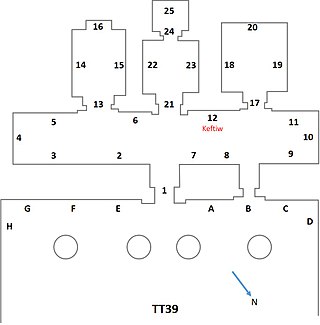
The Theban Tomb TT39 is located in El-Khokha, part of the Theban Necropolis, on the west bank of the Nile, opposite to Luxor. It is the burial place of the ancient Egyptian official, Puimre.

A false door, or recessed niche, is an artistic representation of a door which does not function like a real door. They can be carved in a wall or painted on it. They are a common architectural element in the tombs of ancient Egypt, but appeared possibly earlier in some Pre-Nuragic Sardinian tombs known as Domus de Janas. Later they also occur in Etruscan tombs and in the time of ancient Rome they were used in the interiors of both houses and tombs.

The Theban Tomb TT57 is located in Sheikh Abd el-Qurna. It forms part of the Theban Necropolis, situated on the west bank of the Nile opposite Luxor. The tomb is the burial place of the ancient Egyptian official Khaemhat, who was royal scribe and overseer of double granary, during the reign Amenhotep III. The relief decoration of the tomb is regarded as the best of New Kingdom art.
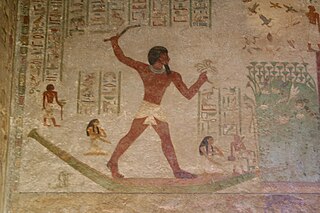
Khnumhotep II was an ancient Egyptian Great Chief of the Oryx nome during the reign of pharaohs Amenemhat II and Senusret II of the 12th Dynasty, Middle Kingdom. He is well known for his tomb at Beni Hasan and its decorations.

Khnumhotep I was an ancient Egyptian Great Chief of the Oryx nome during the reign of Pharaoh Amenemhat I of the 12th Dynasty, Middle Kingdom.

Amenhotep was an ancient Egyptian official and chief physician of the early 19th Dynasty. He is mainly known from his decorated tomb chapel that was excavated in 1913–14 by Ahmed Bey Kamal at Asyut, in Middle Egypt.
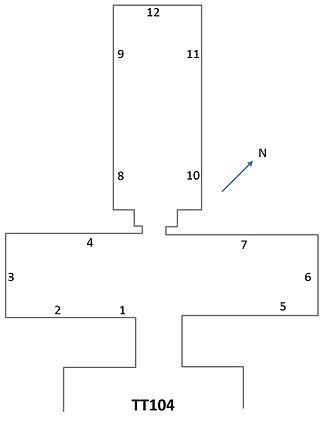
The ancient Egyptian Theban Tomb no. 104 (TT104) belongs to the Overseer of the treasuries Djehutynefer, who was in office under king Amenhotep II. The tomb chapel is located in Sheikh Abd el-Qurna and is part of the Theban Necropolis, on the west bank of the Nile, opposite to Luxor. Djehutynefer had a second tomb in Thebes TT80. Tomb TT104 is decorated with paintings and has a T-shaped ground plan. The paintings are not always well preserved.

Meni, Meny or Menankhpepy was an ancient Egyptian high official who lived during the reigns of Pepy I and Merenre Nemtyemsaf I, in the late Sixth Dynasty. Most of what is known about his life comes from his mastaba burial tomb in the Dendera Necropolis, a few hundred metres south of the Temple to Hathor. This tomb was explored during 1897 and 1898 by a team led by the British archaeologist Flinders Petrie.
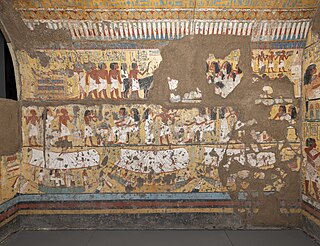
TT338 is the burial place of the ancient Egyptian artist Maya and his wife Tamyt in Deir el-Medina near modern Luxor, Egypt. Maya was titled "outline-draughtsman of Amun" and was active in the late Eighteenth Dynasty. The chapel was probably discovered in the early 1900s. The painted interior depicts the funerary procession and feasts of the deceased; the decoration was detached by the discoverers and is housed today in the Museo Egizio in Turin, Italy.




















